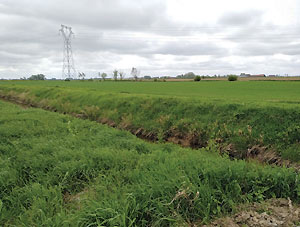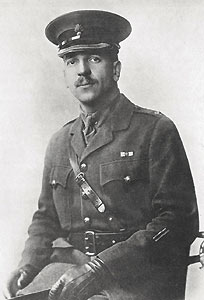|
HAZEBROUCK – ‘THE FORGOTTEN BATTLE’
by The Editor
|
The Battle of Hazebrouck, described by Geoffrey Blades in his excellent paper as the ‘forgotten battle’, took place just over 100 years ago, in early April 1918. Mr Blades was drawn to the story principally because his grandfather, Albert Clement Shipley, serving with the 3rd Battalion Coldstream Guards, had fought in the battle and was captured by the Germans on 12th April 1918.

The battlefield today, looking south-west along the line held by 4th Guards Brigade, with Captain Pryce and his company closest to the camera, on the left
|
The story of this battle is an extraordinary one, described by Sir Frederick Ponsonby in the Household Brigade Magazine in 1920, as ‘perhaps the engagement that will appeal most to future generations .. the glorious stand made by the 4th Guards Brigade near Hazebrouck against overwhelming odds. In all the history of the different regiments no finer performance has ever been recorded’. This is no exaggeration; the story is the essence of what makes the Household Division so special, and we are indebted to Mr Blades for such a detailed account published in 1991, and easily found on the internet; essential reading for anyone visiting the battlefield. 1
The Guards Division moved to the Arras sector in December 1917 as the war on the Eastern Front ended and the Germans began to move divisions to France and Flanders. The BEF had a manpower crisis in early 1918, with many line battalions, but not the Guards, being disbanded to bring others up to strength. In February 1918, 4th Guards Brigade was re-formed with 4th Grenadiers, 3rd Coldstream, and 2nd Irish Guards, and placed under command of 31st Division.
The German offensive began on 21st March, with huge gains along the line and over 20,000 British prisoners taken on that day. This was the Germans’ last chance of a swift victory before the Americans arrived, and they had made an impressive start. The Allies faced the possibility of defeat with Haig issuing his famous order on 11th April: ‘Every position must be held to the last man: there must be no retirement. With our backs to the wall and believing in the justice of our cause each one of us must fight on to the end’.
4th Guards Brigade were soon on their way north to Hazebrouck, just 30 miles from Calais, travelling in London buses in a journey of ten hours along crowded roads. Their task was to block a gap in the line that had opened-up during the German offensive. It was one of the most critical moments in the war, and Oliver Lyttelton, the Brigade Major, recalled the Corps Commander pointing to a large map at Corps HQ: ‘Between these two points there are no British troops. The best German corps on this front is pressing through this gap and, gentlemen, unless you do something before morning there’ll be no more fox-hunting. Good evening gentlemen’. The mission was at least easy to grasp if rather more difficult to execute: to hold the gap until Australian reinforcements arrived.

Captain Thomas Pryce VC MC & Bar,
Grenadier Guards
|
Late on 11th April, 4th Guards Brigade took up its positions along an ill-defined line close to Hazebrouck. The ground was flat, with drainage ditches and hardly any cover, and a shortage of spades left the soldiers badly exposed at dawn. There was no information about flanking units or the enemy, and to make matters worse, there was no food.
The Germans attacked on 12th April, with the Northumberland Fusiliers holding them at bay until 9am. The Brigade Commander, Brigadier-General The Honourable LJP Butler, now had a difficult decision: stay in the gap or move forward to hold the open flank. He decided on the latter and the Grenadiers and Coldstream were ordered to advance to the south-east with the Irish Guards protecting their right flank. Rudyard Kipling later described the Irish Guards, under the command of Lieutenant-Colonel Harold Alexander as ‘working to word and whistle (“like sporting-dog trials”) under and among the shrapnel, whizz-bangs that trundled along the ground, bursts of machine-gun fire and stray sniping’, but still they pushed on.
However, the advance failed with heavy casualties with one Coldstream company down to 40 men, but somehow successive German attacks were halted. The night of 12th April was spent in the open, as there were no trenches, just a number of strongpoints held by a few men. No one knew precisely where they were, ammunition was low, and everyone was tired.
The Germans attacked again the following morning; some Coldstream positions were captured, but the depleted No. 1 Company was still delaying the Germans with Sergeant Vickers in command, sending crisp messages to the Commanding Officer from ‘OC No 1 Coy’. The previous night he reported ‘Situation normal . . . Map reference not known. No map’ before giving a brief account of the earlier fighting and casualties. His message on 13th April was equally succinct, noting his flanking units and the extent of his frontage.
Soon, a German breakthrough on the northern flank left No 2 Company, 4th Grenadiers surrounded close to Vieux-Berquin. In command, Captain Thomas Pryce now sent his last message, ‘My left flank is entirely in the air . . . . Enemy advancing’. By that evening, with no ammunition and only a few men, Pryce gave the order to charge with fixed bayonets that knocked the Germans back, but then they attacked again. Thomas Pryce was killed leading his men, and later awarded the Victoria Cross. One soldier made it back across the lines that night, and 14 were taken prisoner. The Germans had lost momentum, the Australians were firmly in place, and the battle was over.
During this ‘forgotten battle’ a much larger German force had been stopped, Hazebrouck was saved, and a breakthrough to the coast some 30 miles away had been prevented. During three days of battle 4th Guards Brigade (including 12th King’s Own Yorkshire Light Infantry) lost a total of 425 killed, 606 wounded, and 469 taken prisoner. As Sir Frederick Ponsonby wrote in 1920: ‘Orders were issued . . . that every position was to be held to the last man. The 4th Guards Brigade . . . displayed the most heroic courage and tenacity in successfully holding back large numbers of the enemy ... [the battalions now] practically annihilated, the dogged resistance of the survivors led the Germans to imagine they were being opposed by superior numbers’.
By July 1918, the German momentum was faltering as supply lines were extended and casualties mounted. On 8th August the British launched the Battle of Amiens, and the final advance to victory had begun. But the outcome might have been different had 4th Guards Brigade not carried out Haig’s orders to the letter in early April. The Forgotten Battle of Hazebrouck deserves to be remembered 100 years on.
1 The Forgotten Battle - Hazebrouck 1918 - by Geoffrey Blades (1991, 1992) may be found at nickpowley.com/wordpress/. This is the most comprehensive account of the 4th Guards Brigade action at Hazebrouck, with good maps and invaluable information.
|
|


